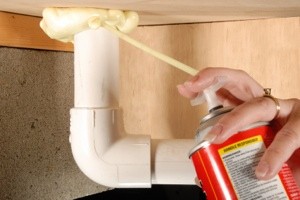
If your house has siding, check the areas around the siding for proper sealing. Homes are insulated behind their siding, but if air can get back there, the insulation can't do its job. Check under the bottom rim of the siding at the foundation of the home and be sure that it's sealed tightly. Likewise, look at holes in the siding around exhaust fans and other areas where air might escape, including the area around the dryer vent and any outside faucets and outlets.
Few people care about drafts in an unfinished basement, but they should. Those drafts cause an overall loss of household atmosphere, and sealing them will keep a more efficiently insulated house. Look at the area where the basement walls meet the ceiling (the underside of your floor) and seal any gaps. Also, look where pipes enter the home, and seal the area around them as well as HVAC ductwork and television cable wires. Do a final check around basement windows, sealing them and repairing cracked glass.
Now go to the extreme other end of the house-the attic. People know to fill attics with insulation, but if the attic is open for storage there are smaller leaks that are left exposed. Replace any attic insulation that looks "old." Discolored and dirty looking insulation needs to be replaced with more efficient insulation.
Heat rises and hot summer sun beats on the roof, so attic sealing is truly key to proper home insulation. Look for electrical wires coming into the home and television reception mounts that need to be sealed with expanding foam. Most homes will have a pipe running from the bathroom plumbing through the attic and out the roof. Seal around this pipe at the roof and the floor of the attic. Don't forget to seal the doorway to the attic with sealant or weatherstripping to prevent drafts from entering the living area below.
Drafts in the living area are usually attended to without a problem. Items like draft blockers for the base of doors and weatherstripping around door jams and windows are common place. Yet, there are many more places where expensive heat can be lost in the living area of the home.
Just like the basement and attic, check the living areas for cracks between the floor and the wall. You won't see them on finished areas, but check under the baseboards where moulding isn't sealing the joint. Ever feel a stream of cold air coming from your outlets? Foam insulation pieces can be added to electrical outlets behind the wall plates.
This page contains the following solutions.
Part of home maintenance is maintaining the exterior. As projects come up (and they always do), why not use the opportunity to go green?